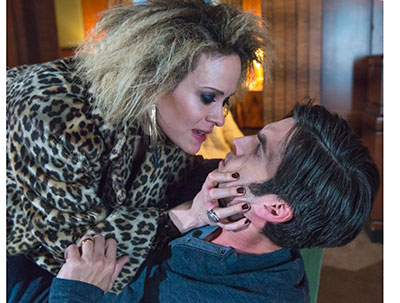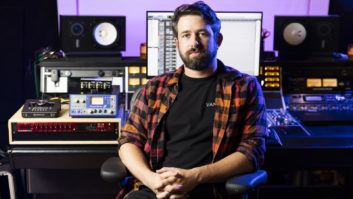
The road to Mac Quayle’s home studio feels like it leads right to the sky. Twist after twist up the Santa Monica Mountains, at times there is a very real sense of falling off the edge of the Earth. Here, ensconced in his remote hideaway with his family, the composer of American Horror Story: Hotel and Freak Show—for which he was nominated for an Emmy for original dramatic score in 2015—creates the sounds that both heighten and complement those series’ terrifying stories.
Quayle has a long history in music, mainly as a dance remixer/producer for pop artists such as Beyonce, Jennifer Lopez, Christina Aguilera, Britney Spears, Madonna and many others, for which he has a tidy collection of gold and platinum discs. His shift into scoring came 10 years ago working as “additional composer.” It was only a year and a half ago that Quayle moved into the sole composer position.
It was Ryan Murphy’s team—the creator, producer, writer, and director behind such television hits as Glee, Nip/Tuck, and the American Horror Story franchise—that gave Quayle this opportunity. Quayle had provided music alongside Cliff Martinez on Murphy’s film, The Normal Heart. He was approached to write a demo piece of music for a scene from Freak Show. Very soon after, Quayle got a call saying, “Can I speak to the new composer of American Horror Story?” Since then, Quayle has become a Ryan Murphy regular, scoring Scream Queens and American Crime Story.
Quayle is given direction as to what overall sound each American Horror Story season is going for, and he is given a script ahead of time. Unlike the conventional method of having a locked picture, a spotting session, cues determined, and then writing music—which is what he has with another show he works on, Mr. Robot—scenes are delivered to him as they are shot.
“For the first month of working with [Murphy], I didn’t have my bearings because I didn’t realize what they were doing,” Quayle says. “I’ll write music and send in not just the stereo mix, but also the stems. As the cut evolves, the editors are cutting the music. They’ll come back to me and say, ‘All of this is working except maybe this one thing. Can you write something else?’ There’s a lot of back and forth. Everything is evolving right up to the last minute. At first I didn’t know what to make of it, but I’ve come to like it. It deepens the operation.”

Mac Quayle. Photo: JennKL Photography
Quayle’s scores for Freak Show and Hotel are deliberately very distinct from each other with none of the sounds from the former being used for the latter. Freak Show is set in the ’50s and has an organic sound, while Hotel takes place in the present—although most of the licensed music is electro-synth-pop from the ’80s, making the score synthetic in feel. It wasn’t Quayle’s intention to create a signature sound for Freak Show, but the sound he gave them based on the direction of “’50s sci-fi film strings” resurfaced again and again in various guises throughout the season, creating a narrative. In contrast, on Hotel, Quayle purposely attempted to come up with an identifiable sound that would work as a through-thread for the season.
Additionally, there are certain sounds that go with certain characters, at least in Quayle’s mind, but they may not remain that way. “In Freak Show, Twisty The Clown had this warped, broken music box-type of circus sound that we used for a lot of his scenes,” says Quayle. “Once Twisty gets taken away, Dandy Mott, the rich psycho takes over, so now the theme starts to apply to him. The editors are noticing when something I’ve written for a particular character works really well for them, and it will keep getting used over and over for that character. But that doesn’t mean they won’t use it somewhere else. I’ve definitely thought, ‘Whoa, that’s an interesting way to use that theme; I wouldn’t have thought to use it for this character, but it works great.’”
Both scores are created in the box with Logic Pro X 10.2.2 as Quayle’s main workhorse. Pro Tools runs on a second machine, where he runs his video and syncs it with Logic. Freak Show’s sounds are primarily drawn from string sample libraries. An accomplished pianist, Quayle also used Imperfect Samples’ piano library and recorded live cello and harmonium for sound sources.
“So many pianos are perfect, clean, every note is exactly right, they sound beautiful and great,” says Quayle. “[Imperfect Samples] is not that. The samples are of a Steinway & Sons, but have little noises, creaking that you would hear if you were recording a real piano. I found that to be pretty useful. This ’50s sci-fi strings sound was a library that sounds like a current-day string section, but with the processing, I like to think I took it back to the ’50s. I came up with this string line, ran it through a guitar amp, plug-ins, then doubled it with a sample of a synth that sounds like a theremin.”
Some of Quayle’s go-to plug-ins are for reverb: Eventide Blackhole Native for its big sound and shimmer and Lexicon PCM Native Random Hall for less shimmer; delays and filters from Soundtoys; and distortion and filtering from Ohm Force Ohmicide, which mangles sounds into something really interesting. Says Quayle, “On Hotel, what might sound like a heartbeat is a low kick drum sound that rather than pulling up a sample, I did with a synth with reverb and delay.”
One way Quayle stops himself from repeating sounds from season to season is by buying new instruments. For Hotel he went with U-He’s Zebra and Diva—which ended up in every cue—plus Rob Papen Predator and Blue II virtual synths. Native Instruments Kontakt synth libraries came in handy, as did Output Signal, which runs in Kontakt.
“My process on all shows is I start with nothing,” says Quayle, who keeps track of his workflow using Google Drive’s Sheets. “The template starts to build as I’m finding my sounds. I come up with a few sounds, start writing, find a few more, write, and I’ve written a cue. Say I’ve got nine sounds, that’s the beginning of the template, which I put into categories like pads and strings, synths, effects, Arps. When I write the next cue, I save a copy. I’ve got those nine sounds, and maybe a couple of them are going to work for this cue, which I can pick from the categories. Now I need some more sounds, and by the end of that cue I’ve got 15 sounds. I’ll open a cue from before if I want that exact collection of sounds and start from there. But cue number three could have sounds that cue number four doesn’t have. At the end of each episode, I organize everything into an official template that has all the sounds I used up until that point in the season. By the end of the season with Hotel, I had 60 or 70 sounds. Having all those sounds sitting there makes it quick.”
With the steep learning curve Quayle has had with deadlines and pressure, quick is of the essence. The aforementioned Google Sheets keep him in check—although they’ve been known to also be a source of procrastination as Quayle adds start and stop times, lengths and moves cues from “under construction” to “delivered” to “under revision” to the last stage of “mixed.” And then does it all over again.







